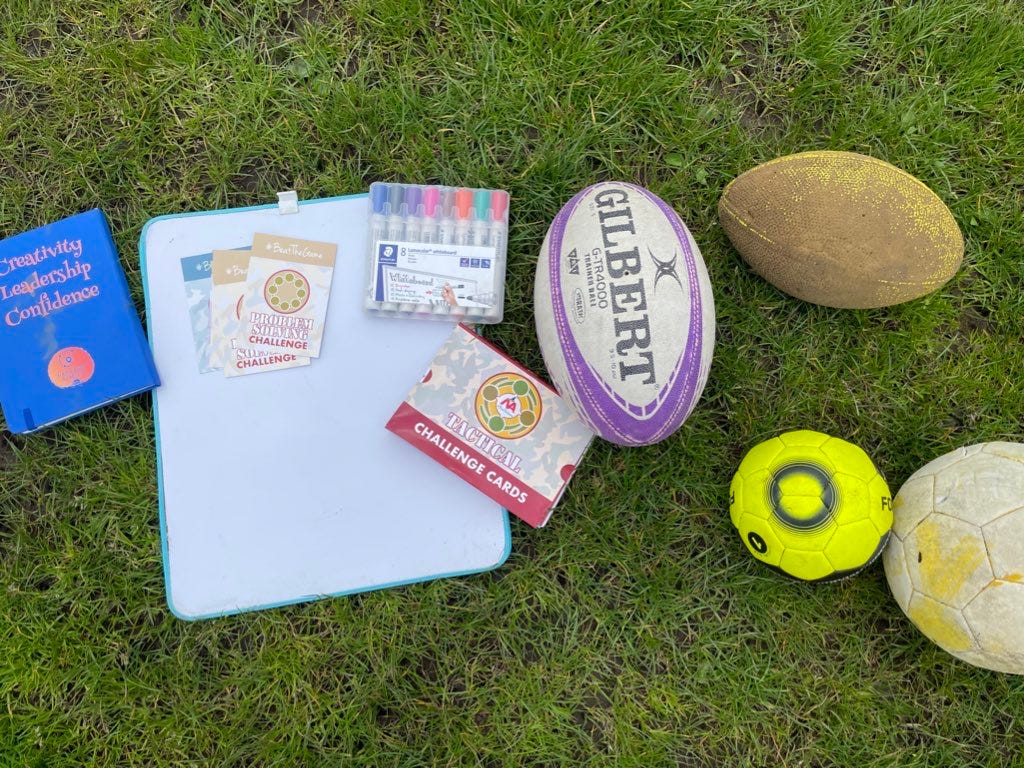How I use Magic Academy Cards in my sessions
Be magical in your sessions by using prompts to challenge your players.
I love the Magic Academy cards. Set up by Russell Earnshaw and John Fletcher, the cards are prompts that you can use in different ways.
There are a range of cards that you can use. This post focuses on how to use the Tactical Challenge Cards (pictured above).
There’s a disclaimer needed: I’m slightly biased as I feature alongside a list of brilliant coaches within this card pack.
The Tactical Challenge Card park has a range of game adaptations and prompts organised into different categories: attack, kick off, transition, problem solving, defence, lineout and scrum.
Why use the cards
Some cards contain helpful tasks that you can include in the planning of your session, such as: co-create a game with your players that has 5 levels.
I often look through the cards whilst I’m planning, they help me think about the structure of the session and how to keep players engaged.
I’ve found they’re very helpful, especially if I’m coaching or planning on my own. They act as another voice to contribute to the session.
I find the cards help me be creative around a theme I’m wanting to focus on. It’s important to encourage creativity within players. To do this, I find coaching within a games-based environment is ideal.
Using cards can help you add adaptations to games that you might not think of and expand your toolbox.
It can also improve how you interact with players. Letting players choose the card to put in the game means they have a different type of interaction with you than the one they may normally have.
You can ask them questions around why they’ve picked that card and how they might use it in the game, why it might benefit the strengths they’ve already showed.
It can also help you encourage leaders within the sessions. I love using the problem solving cards for this, but the act of picking a card and then delivering the information to a group of players also gives players a leadership challenge.
The cards gives you an opportunity to work on different skills as a coach, away just managing a game at a session.
The cards can enable players to manage and change the game. This leaves you then free to challenge, support and enjoy the ride.
Using the cards in a session
The cards can also be used during a session to stretch players and your own coaching skills. There’s multiple ways to use them (including giving them to individual players to see who it affects the game)
When I’m using them in a session, they can act as another co-coach. This is especially useful if I’m coaching on my own.
Here’s how I used them recently:
Pre-selected some cards to use within a game
Set up a game. I used a game of touch.
Allow players time to settle into the game: Give them 5 minutes to play without intervention. This time also allows you to change any cards based on your observations.
Introduce a rule: every 3rd score, a player from each team comes over to the cards. The player from team that just scored comes over to pick a card. The card they picked affects both teams.
Both players have the chance to chat through the cards with myself before returning to their team to brief them.
I gave both teams time to chat through the new rules before restarting the game.
Using the cards in this way enables players to think about how they can respond to the cards and which rule will benefit them the most.
If you have a player who is sitting out of being active in the session, you can give them the cards. Encourage them to talk through options with the rest of the team.
“The challenge cards were great for getting us to think outside the box and change up the way we played as individuals and a team. Different players led on each challenge, giving them opportunity to develop their leadership skills and allowing team mates to support them as they led. A great way to learn new skills, develop new ways of thinking in a game, and build as a team.” - A player
What cards to pick
When I picked the cards, I choose ones I knew would give the right challenges to the team. Link your choice of cards to topics your team is currently working on.
When I picked the cards recently, the team was just finishing a block of sessions focused on tactical warfare. I choose some cards that focused on problem solving and attack.
It’s easy to get overwhelmed when using the cards. There’s alot of choice. However, like interactions with players, it’s important to keep it focused on the central theme of the session.
Want to find out more? Contact Russell Earnshaw
Coaching Care Creativity now has paid subscriptions for people who want to and are able to support the publication



